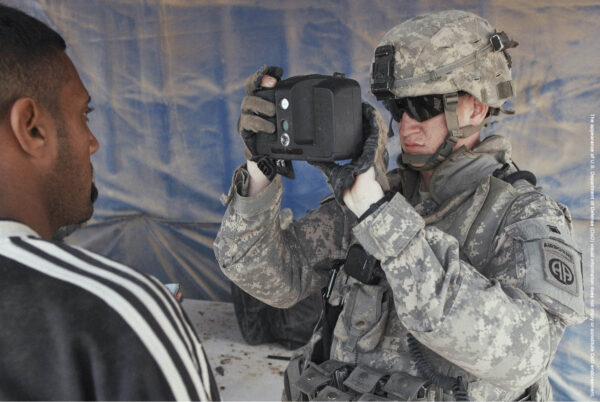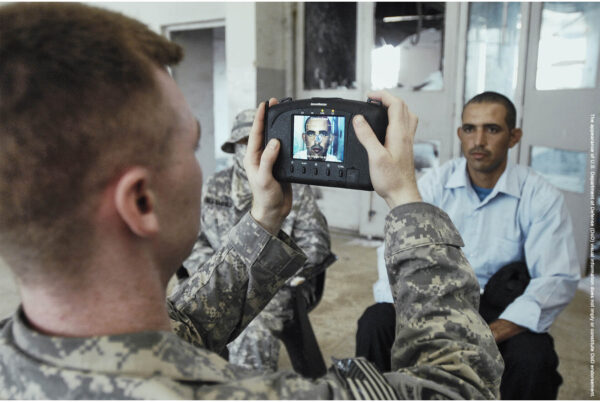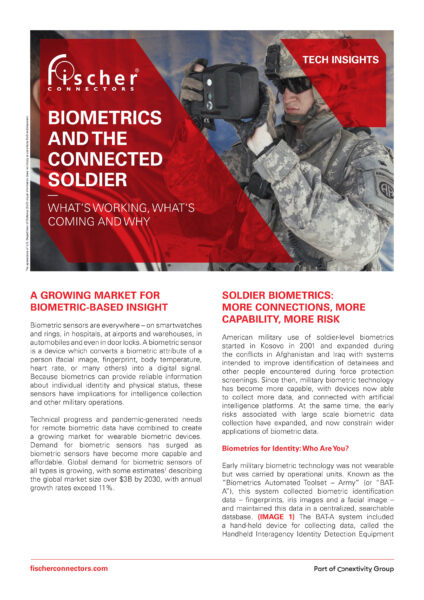Biometric sensors are everywhere – on smartwatches and rings, in hospitals, at airports and warehouses, in automobiles and even in door locks. Because biometrics can provide reliable information about individual identity and physical status, these sensors have implications for intelligence collection and other military operations. Here’s a brief summary of Fischer Connectors’ paper entitled “Biometrics and the Connected Soldier – What’s Working, What’s Coming and Why” published in the ‘Tech Insights’ series.
Soldier biometrics: more connections, more capability, more risk
May 7, 2024 · 2 LesezeitAmerican military use of soldier-level biometrics started in Kosovo in 2001. Since then, military biometric technology has become more capable, with devices now able to collect more data, and connected with artificial intelligence platforms.
Biometrics for identity: Who Are You?
Early military biometric technology was used to verify identity, and encountered two critical flaws. First, these systems were cumbersome and often produced only partial or unusable data in field environments. Second, the huge national biometric databases could be – and were – exploited if they were stolen or hacked.
Biometrics for Health and Fitness: How Are You?
The COVID-19 pandemic led to significant investment by medical device companies in wearable devices to monitor patient vital signs, including respiration, heart rate and other variables. These developments led to military programs to adapt wearable biometrics for assessing soldier health and fitness, including the “Rapid Assessment of Threat Exposure (RATE) Program” – the first combination of soldier-wearable biometrics and artificial intelligence (AI) to assess soldier health.
Biometrics for Operational Effectiveness: Are You Mission-Ready?
Recent Army experiments have begun to test how soldier-worn biometric sensors can help commanders better understand the health status of units in operational environments. A Biometric Wearables Pilot program was included in Exercise TALISMAN SABRE 2023, allowing leaders to see the health readiness of many units operating across a widely dispersed battlefield.
WHAT’S NEXT FOR SOLDIER-WORN BIOMETRICS?
Soldier biometric systems are moving beyond identity management and security applications, toward advanced management of individual and unit fitness, health and readiness.
Technology Drivers Create Possibilities…
As shown by TALISMAN SABRE and the RATE experiments, wearable biometric sensors are becoming smaller, less intrusive and easier for soldiers to wear. Because medical applications are driving sensor development, the trend toward smaller, lighter and less expensive sensors is likely to continue.
At the same time, larger data sets are building around these sensors. Large-scale sports team physical databases, hospital-generated databases related to disease and injury experience, and military fitness and readiness data are now available for training artificial intelligence systems. These systems can help individuals and commanders interpret and apply data from soldier-worn sensors.
… While Practical Constraints Must Be Addressed
Aside from limited funding for soldier biometrics, adoption of these systems appears likely to face four significant challenges. These include the reliability of biometric data, soldier acceptance of wearable sensors, management and security of data, and commanders’ acceptance of biometric-based insights as a decision support tool.
This may be of interest to you
Neue elektronische Lösungen für Extrembedingungen
April 26, 2024 · Lesezeit 4 min


